
views
X
Research source
This simple process can be done easily from home, and most often will result in more radiant, softer skin than before! Generally speaking, when it comes to exfoliating, there are two broad categories to explore: mechanical and chemical exfoliation. While the specific process of exfoliation will depend on the materials and area of focus, you'll find there are many similarities common to each of the techniques. Committing to a proper routine of exfoliation once or twice a week will have your skin looking, and feeling softer than ever before.[2]
X
Expert Source
Melissa JannesLicensed Esthetician
Expert Interview. 30 August 2019.
Exfoliating with Scrubs
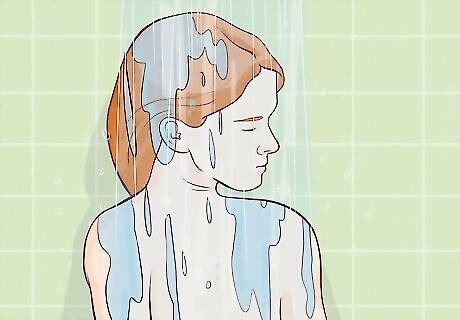
Have a bath or shower. While not part of the exfoliating process per se, immersing your body in hot water will open up your pores, making your skin much more susceptible to cleaning. It also helps to do this process in the bathroom, as you'll need a ready supply of hot water and somewhere to wash away the dead skin flakes once they've been scrubbed off. Use a skin-friendly, perfume-free detergent for bath and allow at least 15 minutes to soften (macerating) the skin surface. It is good when the skin surface looks a bit "deformed". Remove "dead skin" by rubbing it away with your hands. It will work well, especially at your feet, toes and heels.
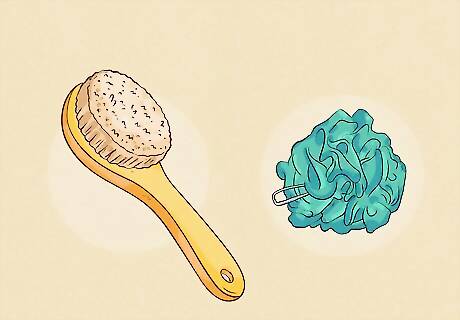
Get a textured sponge to wash your skin. Tending to your skin with it will help rub away excess skin flakes, leaving your skin softer and cleaner than before. It is recommended you have a sponge ready for use once you have finished up your shower. It should feel slightly rough on your skin, but if it's abrasive to the point of pain, exfoliating wash cloths are a suitable, gentler alternative. Exfoliating can also be done with a rough washcloth. A natural bristle brush makes for a good alternative, particularly while scrubbing the backs of arms or legs. If you're the do-it-yourself type, you might look into making your own loofah from home.
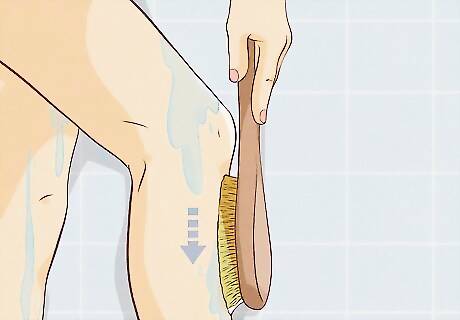
Scrub your body gently with your sponge starting from the ankles upward. Scrub the sponge over your skin in small, circular motions. Make sure to apply some pressure to feel the sponge's rough texture on your skin; that way, it will rub the surface-layer dead skin away. Starting at the ankles is recommended because it helps to encourage positive blood circulation during the exfoliation process. If you're exfoliating your entire body, make sure to give extra attention to your heels, elbows, and knees. These are generally considered to be the driest parts of one's skin, and should be given greater attention accordingly.
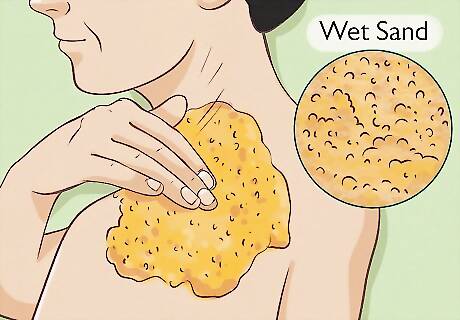
Add wet sand or salt to your full body exfoliation. If you've ever walked along the beach barefoot, you may have noticed your foot callouses soften. Sand granules are a naturally occurring exfoliant, and their grainy texture is well-suited to scraping away your excess skin flakes. Salt scrubs do the same thing. You can find sand and salt exfoliating products at any store that sells beauty and skincare products. Be forewarned: Using sand in the bath can cause a bigger mess than more common exfoliants. Although it is recommended to try it out at least once, it may not be the best course of action if you don't have the added time in your routine available to do a bit of cleaning up afterwards. Getting sand down a drain could completely ruin the plumbing pipes if done often. If using sand, it should be cleaned, even bleached, because getting it from outdoors could introduce bacteria and using that to exfoliate would do more harm than good. Choose sand with small granules, not big, because the smaller granules are more gentle on the skin. Focus on the tougher skin of the arms and legs because sand can be more intense than exfoliating scrubs.

Rinse with hot water. Closing up shop with a body rinse is a relaxing and effective way to finish your exfoliation. Although it's recommended you repeat this process at least three times a week, you should notice an immediate softness with your skin. Applying a moisturizer or shea butter following your rinse, even following an otherwise purely 'mechanical' cleanse, will help your skin better retain moisture.
Using Chemical Exfoliators
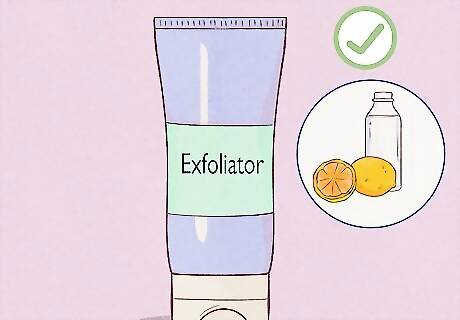
Look for chemical exfoliators at a store. Although calling it 'chemical exfoliation' may carry the pejorative impression of being unhealthy or unnatural for the skin, most chemical exfoliators are actually based in natural ingredients, like fruits, milks, or sugars. Many exfoliators are relatively affordable and readily available at your nearest supermarket.

Have a bath or shower. As with the steps pertaining to mechanical exfoliation, having a hot bath or shower will open up your pores, making your skin easier to clean and exfoliate. Attaching the exfoliating process to an existing part of your daily schedule will make it that much easier to make it part of your routine; keep in mind that exfoliation is best approached as a regular part of your life. You may have softer skin immediately after an exfoliating cleanse, but repetition will yield longer lasting results.
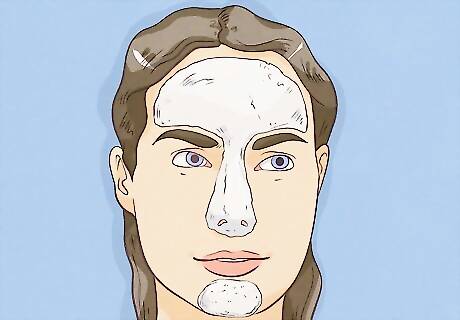
Clean your skin with a store-bought exfoliator. Squirt some exfoliator onto your hands, and begin to rub it onto your skin. Before applying the exfoliator, it's important to make sure your hands are clean; otherwise, you may very well be spreading bacteria to your skin and face. In a gentle, circular motion, swirl the exfoliator around your skin to sweep away any grime and dead skin cells. Take particular care towards exfoliating your face; not only is it the part of you people are going to notice the most, it also carries more oil than other parts of your skin. Three minutes on the face alone should suffice; the rest of the body should warrant a less intensive, but nonetheless attentive do-over with your exfoliator. When exfoliating your face, take proper care to focus on the central area of your face, from the forehead to the nose to the chin. Collectively, this is referred to as the 'T-Zone', and is notorious for its oiliness. If you'd rather not use a commercial product, you can make your own body scrub by mixing Epsom salt or Himalayan pink salt with olive oil, which you can buy in a grocery store where you'd buy commercial products. You can also mix together sugar and an oil (like olive or coconut) for a DIY face scrub. Always be gentle when you apply an exfoliator.
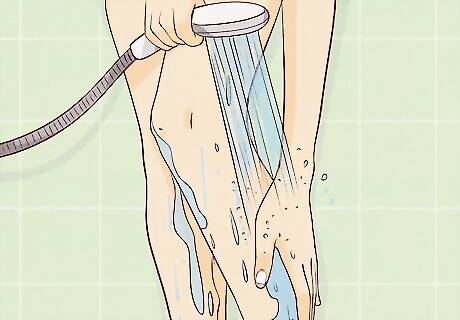
Rinse your body once you have completed your exfoliating cleanse. Take some water in your hands and wash the product away. Making sure the exfoliant is entirely gone will ensure it doesn't irritate your skin later on. Although the chemical exfoliating process requires less of a 'physical' element than its mechanical counterpart, you should find your skin just as soft and smooth following a proper ritual as you would if you'd used the loofah the whole way through.

Apply moisturizer. By applying moisturizer following exfoliating, this should limit the dryness or irritation and improve hydration.




















Comments
0 comment